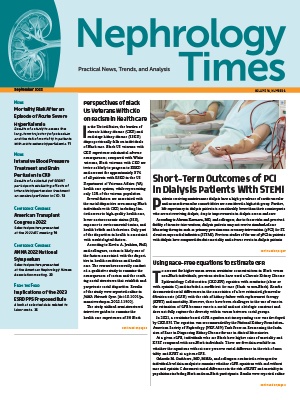
To account for higher mean serum creatinine concentrations in Black versus non-Black individuals, previous studies have used a Chronic Kidney Disease Epidemiology Collaboration (CKD-EPI) equation with creatinine (alone or with cystatin C) and included a coefficient for race (Black vs non-Black). Results documented racial differences in the association of a low estimated glomerular filtration rate (eGFR) with the risk of kidney failure with replacement therapy (KFRT) and mortality. However, there have been challenges to the use of race in the estimation of GFR because race is a social and not a biologic construct and does not fully capture the diversity within versus between racial groups.
In 2021, a creatinine-based eGFR equation not incorporating race was developed by CKD-EPI. The equation was recommended by the National Kidney Foundation–American Society of Nephrology (NKF-ASN) Task Force on Reassessing the Inclusion of Race in Diagnosing Kidney Disease for use in clinical laboratories.
At a given eGFR, individuals who are Black have higher rates of mortality and KFRT compared with non-Black individuals. There are few data available on whether the equations without race preserve racial difference in the risk of mortality and KFRT at a given eGFR.
Orlando M. Gutiérrez, MD, MMSc, and colleagues conducted a retrospective individual-level data analysis to examine whether eGFR equations with and without race and cystatin C document racial differences in the risk of KFRT and mortality in populations including Black and non-Black participants. Results were reported online in JAMA [doi:10.1001/jama.2022.8801].
The analysis included data from five general population and three CKD US-based cohorts with serum creatinine, cystatin C, and follow-up for KFRT and mortality from 1988 to 2018. The exposures of interest were CKD-EPI equation with serum creatinine (eGFRcr with and without race) cystatin C (eGFRcys without race), or both markers (eGFRcr-cys without race).
The primary outcome of interest was the prevalence of decreased eGFR at baseline and hazard ratios (HR) of KFRT and mortality in Black versus non-Black participants. HRs were calculated with adjustment for age and sex. Demographic variables were age, sex, and/or race (ASR). Analyses were conducted within each cohort and with random-effect meta-analyses of the models.
The five population-based cohorts included 18,073 Black participants and 38,017 non-Black participants (2% Asian, 8% Hispanic, 89% non-Hispanic White, and 1% other race and ethnicity). The three CKD cohorts included 2700 Black participants and 321 non-Black participants (15% Hispanic, 78% non-Hispanic White, and 7% other race and ethnicity). The analyses included a total of 62,011 participants. Mean age was 63 years and 53% were women. There were no missing data for age, sex, or race.
The prevalence of eGFR <60 mL/min/1.73 m2 (CKD stage G3+) in Black versus non-Black individuals was 11% versus 12% for eGFRcr(AS), 17% versus 18% for eGFRcys(AS), and 13% versus 11% for eGFRcr-cys(AS) compared with 15% versus 9% among Black versus non-Black individuals for eGFRcr(AS). The Black relative to non-Black prevalence rates of eGFR <60 mL/min/1.73 m2 were 0.98 (95% CI, 0.93-1.03) for eGFRcr(ASR), 0.95 (95% CI, 0.91-0.98) for eGFRcys(AS), 1.2 (95% CI, 1.2-1.3) for eGFRcr-cys(AS), and 1.8 (95% CI, 1.7-1.8) for eGFRcr(AS).
During mean follow-up of 13 years, 8% and 4% of Black and non-Black participants, respectively, experienced KFRT, and 34% and 39%, respectively, died. The 5-year estimated absolute risks of KFRT were 7.3% (95% CI, 6.9%-7.7%) in Black participants and 3.9% (95% CI, 3.7%-4.1%) in non-Black participants overall. For all equations, in both Black and non-Black populations, there was a significantly greater risk of KFRT at lower versus higher eGFR. After adjustment for age and sex, the risks of KFRT were significantly higher in Black participants compared with non-Black participants for eGFRcr(ASR), eGFRcys(AS), and eGFRcr-cys(AS) across all eGFR levels.
For all equations, there were associations between decreased eGFR and significantly higher age- and sex-adjusted risk for all-cause and cardiovascular mortality. Compared with non-Black participants, Black participants had a significantly higher risk of mortality at an eGFR of 60 mL/min/1.73 m2 for nearly all estimates for eGFRcr(ASR), eGFRcys(AS), and eGFRcr-cys(AS).
There were associations between decreased eGFR and significantly greater risk for both outcomes for all equations. At an eGFR of 60 mL/min/1.73 m2, the HRs for KFRT comparing Black with non-Black participants were 2.8 (95% CI, 1.6-4.9) for eGFRcr with race, 3.0 (95% CI, 1.5-5.8) for eGFRcys, and 2.8 (95% CI, 1.4-5.4) for eGFRcr-cys versus 1.3 (95% CI, 0.8-2.1) for eGFRcr without race.
The 5-year absolute risk differences for KRFT comparing Black with non-Black participants were 1.4% (95% CI, 0.2%-2.6%) for eGFRcr with race, 1.1% (95% CI, 0.2%-1.9%) for eGFRcys, and 1.3% (95% CI, 0%-2.6%) for eGFRcr-cys versus 0.37% (95% CI, –0.32to 1.05%) for eGFRcr without race. Patterns were similar for mortality.
The researchers cited some limitations to the study findings, including the lack of specific data on factors that may differ between racial groups (eg, measures of social determinants of health), the possibility of unmeasured heterogeneity in methods of measurements across cohorts, insufficient numbers of participants from racial and ethnic groups other than Black and White precluding comparison of outcomes across other race and ethnic groups, lack of data on measured GFR in some of the cohorts, and the study design addressing discrimination but not calibration.
In conclusion, the researchers said, “In this retrospective analysis of eight US cohorts including Black and non-Black individuals, the eGFR equation without race that included creatinine and cystatin C, but not the eGFR equation without race that included creatinine without cystatin C, demonstrated racial differences in the risk of KFRT and mortality throughout the range of eGFR. The eGFRcr-cys equation may be preferable to the eGFRcr equation without race for assessing racial differences in the risk of KFRT and mortality associated with low eGFR.”
Takeaway Points
- Results of an analysis assessing whether estimated glomerular filtration rate (eGFR) equations with and without race and cystatin C altered risk estimates for kidney failure with replacement therapy (KFRT) and mortality for Black versus non-Black participants.
- There was a relationship between decreased eGFR and higher risk for all equations and within both racial groups.
- The eGFR equation including both creatinine and cystatin c, but not the equation including creatinine without cystatin C, yielded racial differences in the risks of KFRT and mortality.







 © 2025 Mashup Media, LLC, a Formedics Property. All Rights Reserved.
© 2025 Mashup Media, LLC, a Formedics Property. All Rights Reserved.